第十二章 数理经济学派
- 格式:ppt
- 大小:84.00 KB
- 文档页数:18
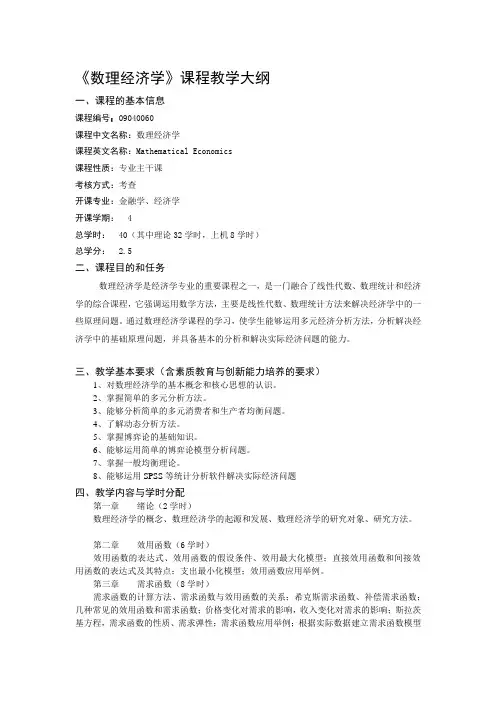
《数理经济学》课程教学大纲一、课程的基本信息课程编号:09040060课程中文名称:数理经济学课程英文名称:Mathematical Economics课程性质:专业主干课考核方式:考查开课专业:金融学、经济学开课学期:4总学时:40(其中理论32学时,上机8学时)总学分: 2.5二、课程目的和任务数理经济学是经济学专业的重要课程之一,是一门融合了线性代数、数理统计和经济学的综合课程,它强调运用数学方法,主要是线性代数、数理统计方法来解决经济学中的一些原理问题。
通过数理经济学课程的学习,使学生能够运用多元经济分析方法,分析解决经济学中的基础原理问题,并具备基本的分析和解决实际经济问题的能力。
三、教学基本要求(含素质教育与创新能力培养的要求)1、对数理经济学的基本概念和核心思想的认识。
2、掌握简单的多元分析方法。
3、能够分析简单的多元消费者和生产者均衡问题。
4、了解动态分析方法。
5、掌握博弈论的基础知识。
6、能够运用简单的博弈论模型分析问题。
7、掌握一般均衡理论。
8、能够运用SPSS等统计分析软件解决实际经济问题四、教学内容与学时分配第一章绪论(2学时)数理经济学的概念、数理经济学的起源和发展、数理经济学的研究对象、研究方法。
第二章效用函数(6学时)效用函数的表达式、效用函数的假设条件、效用最大化模型;直接效用函数和间接效用函数的表达式及其特点;支出最小化模型;效用函数应用举例。
第三章需求函数(8学时)需求函数的计算方法、需求函数与效用函数的关系;希克斯需求函数、补偿需求函数;几种常见的效用函数和需求函数;价格变化对需求的影响,收入变化对需求的影响;斯拉茨基方程,需求函数的性质、需求弹性;需求函数应用举例;根据实际数据建立需求函数模型(上机)。
第四章生产函数(10学时)一种生产要素可变情况下的生产函数、若干种生产要素可变情况下的生产函数;生产要素的最佳组合,利润最大化模型、成本最小化模型;影子价格;产量变化对均衡的影响、规模收益;生产函数应用举例;根据实际数据建立某企业生产函数模型(上机);根据实际数据建立我国生产函数模型(上机)。

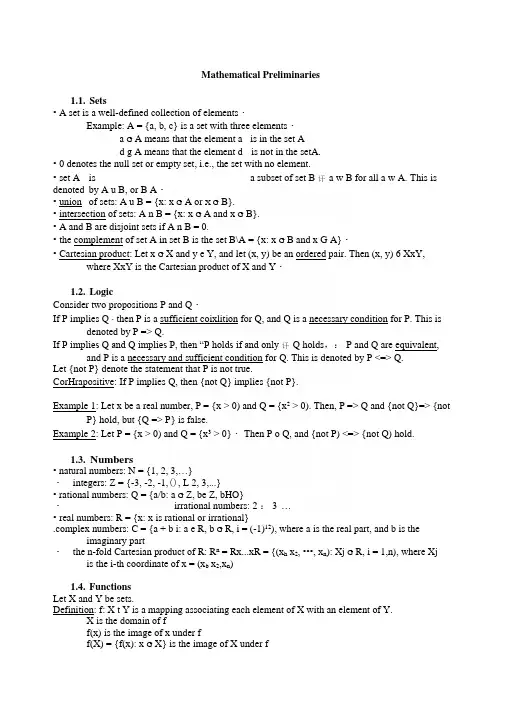
Mathematical Preliminaries1.1.Sets•A set is a well-defined collection of elements・Example: A = {a, b, c} is a set with three elements・a G A means that the element a is in the set Ad g A means that the element d is not in the setA.•0 denotes the null set or empty set, i.e., the set with no element.•set A is a subset of set B 讦a w B for all a w A. This is denoted by A u B, or B A・•union of sets: A u B = {x: x G A or X G B}.•intersection of sets: A n B = {x: x G A and x G B}.•A and B are disjoint sets if A n B = 0.•the complement of set A in set B is the set B\A = {x: x G B and x G A}・•Cartesian product: Let x G X and y e Y, and let (x, y) be an ordered pair. Then (x, y) 6 XxY, where XxY is the Cartesian product of X and Y・1.2.LogicConsider two propositions P and Q・If P implies Q、then P is a sufficient coixlition for Q, and Q is a necessary condition for P. This is denoted by P => Q.If P implies Q and Q implies P, then “P holds if and only 讦Q holds,: P and Q are equivalent, and P is a necessary and sufficient condition for Q. This is denoted by P <=> Q.Let {not P} denote the statement that P is not true.CorHrapositive: If P implies Q, then {not Q} implies {not P}.Example 1: Let x be a real number, P = {x > 0) and Q = {x2 > 0). Then, P => Q and {not Q}=> {not P} hold, but {Q => P} is false.Example 2: Let P = {x > 0) and Q = {x3 > 0}・ Then P o Q, and {not P) <=> {not Q) hold.1.3.Numbers•natural numbers: N = {1, 2, 3,…}・integers: Z = {-3, -2, -1,(), L 2, 3,...}•rational numbers: Q = {a/b: a G Z, be Z, bHO}・irrational numbers: 2 : 3 …•real numbers: R = {x: x is rational or irrational}.complex numbers: C = {a + b i: a e R, b G R, i = (-1)12), where a is the real part, and b is the imaginary part・the n-fold Cartesian product of R: R n = Rx...xR = {(x h x2, •••, x n): Xj G R, i = 1,n), where Xj is the i-th coordinate of x = (x b x2,x n)1.4.FunctionsLet X and Y be sets.Definition: f: X t Y is a mapping associating each element of X with an element of Y.X is the domain of ff(x) is the image of x under ff(X) = {f(x): x G X} is the image of X under f•a function: if only one point in Y is associated with each point in X・ a coirespondence: if more than one point in Y can be associated with each point in X •inverse function: x = f *(y) if and only if y = f(x).a function f: X T Y is onto 讦f(X) = Y.It means that the equation f(x) = y has at least one solution for each y.•if f(x) and f ly) are both single・valued, then f is on—to-one.It means that the equation f(x) = y has at most one solution for each y.•composite function: h = g(f(x)) = g • f is the composition of f with g satisfying f: A t B u C, g:C t D, g • f: A t D.L5e BoundsLet S c R.•S is bounded from above (from below)讦there exists a G R (b G R) such that x < a (x > b) for all x G S. Then, a is an upper bound of S, and b is a lower bound of S・•The least upper bound (lub) or suDremum (sup) of S is the upperbound of S such that there does not exist a smaller upper bound. It is denoted by sup(S).•The supremum of S is called a maximum (max) of S if sup(S) G S. It is denoted by max(S). •The greatest lower bound (gib) or infimum (inf) of S is the lower bound of S such that there does not exist a larger lower bound. 1( is denoted by inf(S).•The infimum of S is called a minimum (min) of S if inf(S) e S. It is denoted by min(S).• Property:If S c R and S has an upperbound, then S has a supremum.If S u R and S has a lowerbound, then S has an infimum.16 Vector SpaceConsider a set V.LI- associative law: x + (y + z) = (x + y) + z, for all x, y, z, w VL2- identity: there exists O G V such that x + 0 = x for all x G VL3- inverse: there exists (-x) e V such that x + (-x) = 0 for all x e VL4- commutative law: x + y = y + x for all x, y G VL5- associative law: a・([3・x) = (a-p) x for all a, p e R, and for all x G VL6- identity: there exists 1 G V such that l x = x for all x e VL7- distributive law: a・(x + y) = a x + a y for all ae R, and for all x, y w VL8- distributive law: (a + p)-x = a x + p x for all a,卩G R, and for all x G V L9- closure: x e V and y G V implies that (x + y) G V LIO- closure: x G V and ae R implies that (a・x) e V. Definition: A set V is vector space (or linear space) if it satisfies Ll-Ll0. Then x G V is called a vector. Examples: R l\ or C n is each a vector space.1.7. Norms and distancesConsider a function d(x, y) satisfying:M1: d(x, y) = 0 if and only if x = y M2: d(x, y) + d(y, z) > d(z, x) M3: d(x, y) > 0 for all x, y M4: d(x, y) = d(y, x).Definition: For a given set X,讦a function d: XxX —> R satisfies M1-M4, then: X is a metric space, denoted by (X, d)d is a metricd(x, y) is the distance between points x and y.Examples:di(x,y) = [Zi (xj - yi)2!12 = Euclidian distance,denoted by ||x - y||d2(x, y) = maxi 风-y s|d3(x, y) = Zi lx, - y.lNote: Topology consists in studying the properties of sets that are independent of the distance measure chosen.Definition: Let V be a vector space・ A real value function N: V t R is called a norm on V if: N(x) > 0 for all x G V N(x) = 0 if and only if x = 0N(r x) = |r| N(x) for all re R and x e V, andN(x + y) < N(x) + N(y) for all x, y G V.Example: N(x) = d|(x, 0) = [Xi (xj)2]12 = ||x|| is the Euclidian noim of x in R.R n, with Euclidian norm and Euclidian metric, is a normed vector space.Every normed vector space is a metric space with respect to the induced metric defined by d](x, y) = llx - yll.Convex SetsLet X be a vector space (e.g・,X = R n).Definition: A set S c: X is convex if any x, y G S implies that(0x + (1-0) y) e S, for all 0 e R, 0 < 0 < 1.Note: (0 x + (1-0) y) is called a linear combination of x and y.Properties:・Any intersection of convex sets is convex.•Let Si, i = 1,m, be convex sets in vector space X. Then:•(Ejei (Xj Si) = {x: x = Z i=i■•…m oti Xi, XjG Sj, otf R, i = 1,…,Hi} is a convexset.•(SixS2x...xS m) = x i=1■•…m (Si) is a convex set.L9. Compact SetsLet S u R n.Definition: An open ball about x0 e R n with radius r e R, r > 0, is defined as:B r(x0) = {x: x G S, d(x, x0) < r}, where d(x, x0) is the Euclidian distance betweenpoints x and x0.Definition: An open set S u R n is a set S such that, for each x e S, there exists an open ball B r(x) completely contained in S.• The union of open sets is open..A finite intersection of open sets is open.Definition: The inierior of a set S, denoted by int(S), is the union of all open sets contained in S..A set S is open 讦and only 讦S 二int(S).Definition: A set S c R n is closed 讦the set (R n\S) is open.・The intersection of closed sets is closed・.A finite union of closed sets is closed・Definition: The closure of a set S, denoted by cl(S), is the intersection of all closed sets containing S..A set S is closed if and only if S = cl(S).Definition: The boundary of a set S u R" is the set cl(S)ncl(R n/S).Definition: A set S is bounded if there exists an open ball with a finite radius which contains S・Definition: A collection of open sets (S a)a€A in a metric space X is said to be an open cover of a given set S u R n if S u 低入 S a.The open cover (S a)ae A of S is said to admit a finite subcover if there exists a finitesubcollection (SQ^F such that S u S®Definition 1: A set S c R n is compact if and only if it is closed and bounded・Definition 2: A subset S of a metric space X is compact if and only if every open cover of S has a finite subcover.Note: The definition 2 of compactness applies to sets in any metric space, while definition 1 applies only to sets in R n.LIO. SequencesLet (X, d) be a metric space (e.g., X = R n), and let S c X.Definition: A sequence {xj: j = 1,g} in S converges to y if, for any e > 0, there exists a positive integer j" such that j hj,implies d(y, xj) < e.This is denoted by y = limj* {xj, where y is the limit of {Xj}.Note: It does not follow that y = lirOjT® {xj} G S・Definition: A sequenee {Xj: j = 1,…,g} in S is a Cauchy sequence if for any e > 0, there exists a positive integer such that, for any ij > j\ d(x i9 Xj) < £.Definition: If every Cauchy sequence in a metric space is also a convergent sequence, then the* A sequence {xp j = 1,…严} in R" is a Cauchy sequence if and only if it is a convergent sequence, i.e. if and only if there is y G R n such that linij》{Xj} —> y.metric space is said to be complete.By the above definition, this implies that R n is complete (although not all metric spaces are complete)・Definition: Let m(j) be an increasing function: m: {12 3,…} T {1, 2, 3,such that m(k+l) > m(k).Given a sequence {xj: j = 1, 2,…,g}, {m = 1,…,g} is a subsequence of {xj: j =1,2,…,oo}..A set S c R n is closed if and only if every convergent sequenee of points in S converges to a point in S・・ A set S e R n is compact if and only if every sequence in S has a convergent subsequence whoselimit is in S.・ A sequence {xj: j = 1, 2,…,g} in R n converges to y if and only if every subsequence of {xj: j =1,…,g} converges to y.・Every bounded sequence contains a convergent subsequence・Definition: A sequence {xj: j = 1,2,…,oo} is (strictly) increasing if, for all m > n, x m > (>) x n for all n.A sequence {xj: j = 1,2,…,<»} is (strictly) decreasing if, for all m > n, x m < (<) x n forall n・Let X u R, X H 0. If X is bounded from above (below), there exists an increasing (decreasing) sequence in X converging to sup(X) (inf(X)).Definition: Assume that ±oo are allowed as limits of a sequence.The lim sup of the sequence {xj: j = 1,in R is defined as limj^oo {可:j =1,2 •••}, where aj = sup{xj, Xj+b Xj+2. ...}・ It is denoted by linij^oo supk>j x k, or simply by lim SUpjTco Xj・The lim inf of the sequence {Xj: j = 1,in R is defined as limj^ {bj: j = 1,2 …}, where bj = inf{x jt Xj+i, x i+2, ...}. It is denoted by inf k>j x k, or simply by lim infj†Xj・† A sequence xj in R converges to a limit y G R if and only if y = lim supj* Xj = lim in与* Xj.。
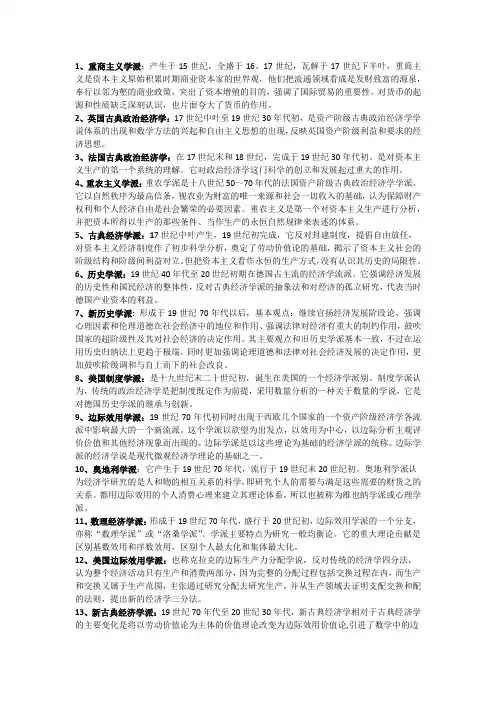
1、重商主义学派:产生于15世纪,全盛于16、17世纪,瓦解于17世纪下半叶,重商主义是资本主义原始积累时期商业资本家的世界观,他们把流通领域看成是发财致富的源泉,奉行以邻为壑的商业政策,突出了资本增殖的目的,强调了国际贸易的重要性。
对货币的起源和性质缺乏深刻认识,也片面夸大了货币的作用。
2、英国古典政治经济学:17世纪中叶至19世纪30年代初,是资产阶级古典政治经济学学说体系的出现和数学方法的兴起和自由主义思想的出现,反映英国资产阶级利益和要求的经济思想。
3、法国古典政治经济学:在17世纪末和18世纪,完成于19世纪30年代初。
是对资本主义生产的第一个系统的理解。
它对政治经济学这门科学的创立和发展起过重大的作用。
4、重农主义学派:重农学派是十八世纪50~70年代的法国资产阶级古典政治经济学学派。
它以自然秩序为最高信条,视农业为财富的唯一来源和社会一切收入的基础,认为保障财产权利和个人经济自由是社会繁荣的必要因素。
重农主义是第一个对资本主义生产进行分析,并把资本所得以生产的那些条件、当作生产的永恒自然规律来表述的体系。
5、古典经济学派:17世纪中叶产生,19世纪初完成,它反对封建制度,提倡自由放任,对资本主义经济制度作了初步科学分析,奠定了劳动价值论的基础,揭示了资本主义社会的阶级结构和阶级间利益对立。
但把资本主义看作永恒的生产方式,没有认识其历史的局限性。
6、历史学派:19世纪40年代至20世纪初期在德国占主流的经济学流派。
它强调经济发展的历史性和国民经济的整体性,反对古典经济学派的抽象法和对经济的孤立研究,代表当时德国产业资本的利益。
7、新历史学派: 形成于19世纪70年代以后,基本观点:继续宣扬经济发展阶段论、强调心理因素和伦理道德在社会经济中的地位和作用、强调法律对经济有重大的制约作用,鼓吹国家的超阶级性及其对社会经济的决定作用。
其主要观点和旧历史学派基本一致,不过在运用历史归纳法上更趋于极端,同时更加强调论理道德和法律对社会经济发展的决定作用,更加鼓吹阶级调和与自上而下的社会改良。


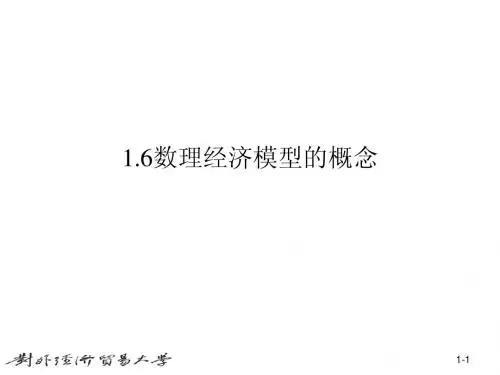
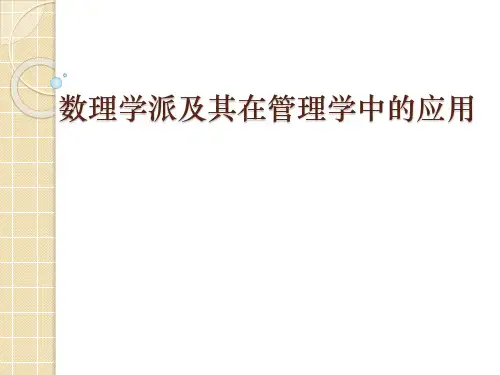
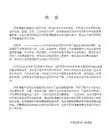

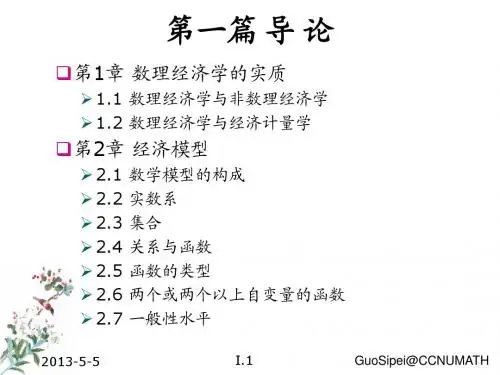
经济学分支介绍(11)——数理经济学(一)数理经济学是运用数学方法对经济学理论进行陈述和研究的一个分支学科。
在经济史上把从事这样研究的人叫做数理经济学家,并且归为数理经济学派,简称数理学派。
西方第一个把数学用于经济问题的是意大利的切瓦,他于1711年写了一本关于货币价值的书。
但首先比较系统地运用数学的,是1838年法国库尔诺的《财富理论数学原理的研究》,这书常被当做数理经济学的开端。
由于当时的经济理论权威们不熟悉数学推理,而无人问津,直到40年后因受到英国的杰文斯和法国的瓦尔拉斯的高度推崇,才知名于世,并被当做数理经济学和数理学派的正式起源。
此后英国的埃奇沃思、马歇尔、美国的费希尔、意大利的帕累托等进一步发展了数理经济学。
库尔诺并没有用过“数理经济学”的名称,他采用的书名用意不仅在于理论研究,而且在研究中要运用数学分析的形式和符号。
他认为在财富理论中运用数学分析,是为了探索不能用数字表现的数量之间的关系,和不能用代数表现的函数之间的关系;即使不需要精确数字,只要能更简明地陈述问题、开辟研究途径、避免脱离主题,数学也有其有用之处,如果仅仅因为不熟悉或怕用错而拒绝数学分析,是荒谬的。
杰文斯1862年发表的论文《略论政治经济学的一般数学理论》是数理经济学的最早名称,到1879年他的主要著作《政治经济学理论》一书再版时,附上1711年以来的“数学的经济的”文献目录,等于公开宣称数理经济学的存在。
他认为经济学要成为一门科学,必须是一门依赖于数学的科学,简单原因就是研究数量和数量之间的复杂关系,必须进行数学推理,即使不用代数符号,也不会减少这门科学的数学性质。
杰文斯的目的是要为价值的最终理论以及建立在这个理论之上的市场规律提供数学解说。
他的理论中心是“价值完全由效用决定”。
他把商品对所有者的效用分为总效用和最后程度的效用(即后来的边际效用),后者是商品拥有或消费总量增加时,总效用增加量对商品增加量的比率。